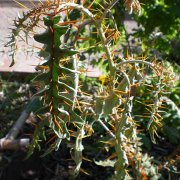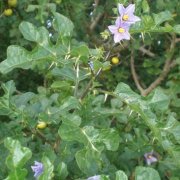Care of the plant Solanum pseudocapsicum or Jerusalem cherry |
|
The genus Solanum, family Solanaceae, comprises 1,700 species distributed throughout the planet. Some species are: Solanum pseudocapsicum, Solanum jasminoides, Solanum giganteum, Solanum wendlandii, Solanum rantonnetii, Solanum capsicastrum, Solanum crispum, Solanum pyracanthum, Solanum evening, Solanum melongena, Solanum mauritianum. Common names: Jerusalem cherry, Madeira winter cherry, Winter cherry. This species is native to South America. They are evergreen shrubs that reach 1.20 meters (47.24") in height. The leaves are oblong or lanceolate in shape and deep green in color. The flowers are white and small (1.5 cm); they bloom in late spring. The fruits are toxic but very decorative; They appear in summer and are first green, then orange, and finally red. Jerusalem cherry is used in Mediterranean climate gardens to form flower beds and clumps and in pots as houseplants in colder climates. It's important to remember that the fruits are toxic and must be out of the reach of small children. Solanum pseudocapsicum needs a sunny exposure, either outdoors or indoors. It does not resist frost. The soil can be light, drained, normal garden soil. Water abundantly in spring and summer so that the soil does not dry out completely; reduce watering in fall and winter. Fertilize every 15 days with mineral fertilizer during the summer. Prune intensively at the end of winter if it loses its leaves to favor new spring shoots. Solanum pseudocapsicum can be attacked by aphids; it's prone to diseases such as powdery mildew and mildew. Madeira winter cherry is propagated from seeds sown in late winter. |
Images of the plant Solanum pseudocapsicum or Jerusalem cherry |
Find plants
Solanum pseudocapsicum or Jerusalem cherry | Care and Growing
© 2025 FavThemes











